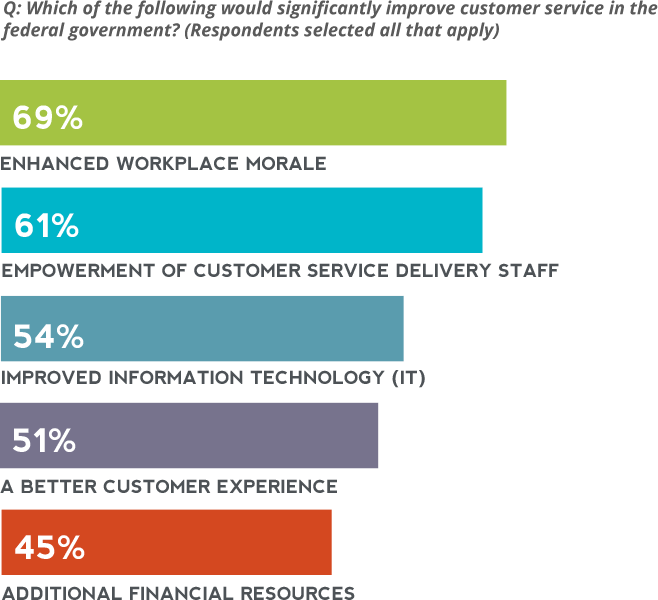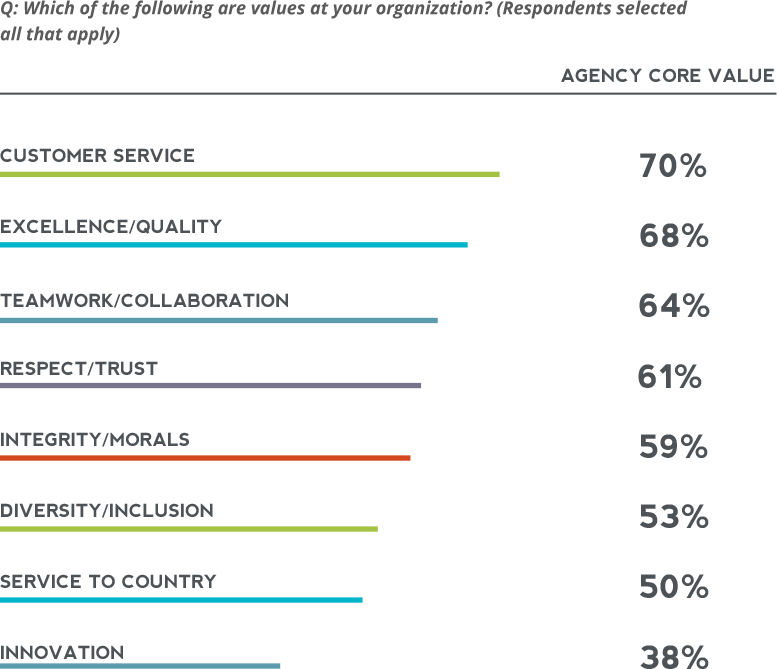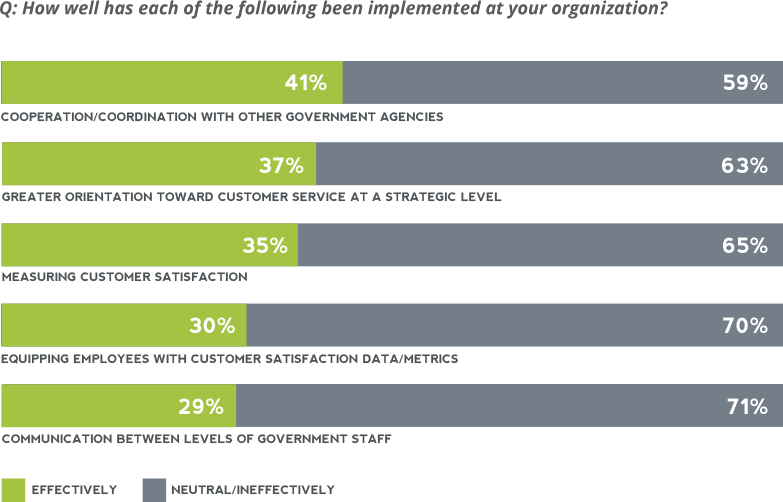Report
Improving customer service in federal government: Key insights

The most recent President’s Management Agenda and OMB Circular No. A-11 Section 208 have brought the topic of government customer service front and center. These publications put a real stake in the ground: agencies have to make “improving customer experience” a priority.
We already know that government agencies are striving to match expectations shaped by citizens’ best customer experiences elsewhere. They have been for well more than a decade. Yet we also see they aren’t succeeding as they might like. Why?
THE 2017 AMERICAN CONSUMER SATISFACTION INDEX SHOWS THAT, ON AVERAGE, PUBLIC ADMINISTRATION/GOVERNMENT SERVICES LAG 6.7 PERCENTAGE POINTS BEHIND THE PRIVATE SECTOR.
Source: The ACSI Benchmarks By Sector
Eagle Hill Consulting undertook a survey of federal employees to find out. By looking from the inside out, we gained a straightforward perspective on the customer service challenges and opportunities from those operating right at the core.
Over the next few weeks, we’ll share these insights into how well government is succeeding in delivering customer service and how it can improve.
What we found may surprise you.
According to federal employees, an improved customer experience begins with workforce culture. Tech plays a supporting role.
Our survey’s main takeaway is that government customer experience improvements may rely less on technology upgrades than on culture improvements—namely, a workforce who are invested and engaged, supported and rewarded by leadership. See Figure 1. This makes sense; ultimately, it’s the federal workforce who get the customer service job done. They work for the citizenry; they solve problems for the public. The technology is one (albeit, highly enabling) tool. It should not be the end game—nor even the starting point.
FIGURE 1: MORE EMPLOYEES SAY CULTURE ELEMENTS (VERSUS IMPROVED TECHNOLOGY) WILL SIGNIFICANTLY IMPROVE CUSTOMER SERVICE

Source: 2018 Eagle Hill Consulting Federal Government Customer Service Survey
However, technology tends to dominate the government customer service conversation in the media; match a quick Internet search of the phrase “improve government customer service” with the word “technology” and you’ll get about 336,000,000 more hits than when you match the phrase with “culture.”
Employees say that customer service is a core value at their agency, but rate performance on critical factors low
The first step for the federal government may be to give more weight to its words through targeted actions. Consider the divide shown in Figure 2. More than 70 percent of respondents identify customer service as a core value in their organization. Yet on average, only 31 percent of employees rank their organization as being effective at achieving elements critical to customer service.
FIGURE 2: THE VALUES GAP

Source: 2018 Eagle Hill Consulting Federal Government Customer Service Survey
Employees are getting the message that customer service matters—a lot. In fact, customer service ranks highest in terms of agency core values (see Figure 3). But they are not seeing it supported accordingly. Less than half of employees say their organization is effective at activities identified as critical elements of customer service (see Figure 4). For agencies working within constrained budgets (and which ones aren’t?), focusing efforts on specific behaviors that employees say are critical will be part of the answer.
FIGURE 3: CUSTOMER SERVICE RANKS HIGHEST IN TERMS OF AGENCY CORE VALUES

Source: 2018 Eagle Hill Consulting Federal Government Customer Service Survey
FIGURE 4: LESS THAN HALF OF EMPLOYEES SAY THEIR ORGANIZATION IS EFFECTIVE AT ACTIVITIES IDENTIFIED AS CRITICAL ELEMENTS OF CUSTOMER SERVICE

*Note: 18% of respondents chose “other” as a response.
Source: 2018 Eagle Hill Consulting Federal Government Customer Service Survey
While a technology program alone will not ensure customer service improvements, federal employees seem in agreement that investments in culture will; sound investments here can yield fast dividends. Put another way, whatever goals agencies have for modernizing IT, technology should not be viewed as the driver of better service. It enables. Even if agencies were to spend no money on IT, they could still improve government customer service through culture changes and employee empowerment.
Strong leaders, supportive cultures, systematic measurement… success
Clearly, federal employees already see themselves as having a customer-oriented mindset. They identify customer service as a core organizational value. What our survey says they need now are the leadership and support structures to follow through on exceptional delivery.
In coming weeks, Eagle Hill will share with you our most intriguing findings and recommendations on how to begin putting those support structures for improved customer service in place. Stay tuned for insights on the changes governments can make to better measure progress, structure their organization and leadership for success, and develop cultures that foster customer service excellence.
Methodology
The 2018 Eagle Hill Consulting Federal Government Customer Service Survey was conducted online by Government Business Council between June and July 2018. The online survey included 625 respondents from a random sample of respondents across the Federal Government (including civilian and Department of Defense agencies).

